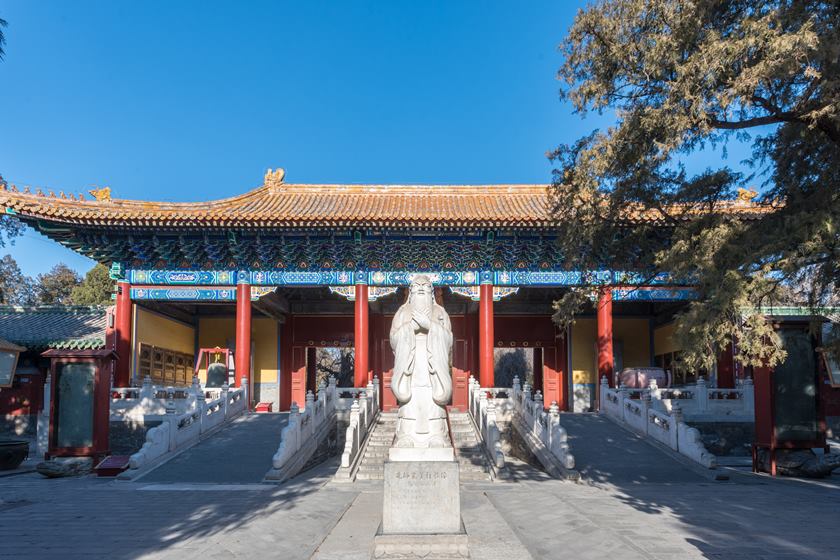Chinese Name: 孔庙 Pronunciation: kǒng miào
Recommended Time for Visit: 1-2 Hours
Best Visiting Season: All Seasons
Occupied Area: 22000 Square meters
Building Area: 7,400 square meters
Building Time: 1306
Admission Ticket Fare: 30 yuan
Address: Guozijian Street, Dongcheng District, Beijing
Building Function: An ancient museum; a place for rulers of all dynasties to sacrifice to Confucius and worship Confucianism.
|
Park Gate
|
Peak Season
(May 1st to October 31st)
|
Low Season
(November 1st to April 30th)
|
| Opening Hours | 8:30-18:00 | 8:30-17:00 |
| Ticket Office Opening Hours | 8:30-17:00 | 8:30-16:30 |
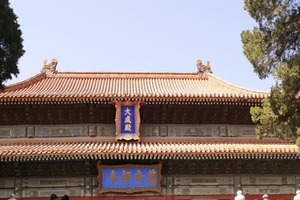
Confucius(BC551-BC479), a famous thinker and educator in ancient China, the founder of the Confucian School, was later honored as a sage, the holiest master and so on. He was also the first one of the "world's ten cultural celebrities". He first began to give private lectures. Confucius had learned from Laozi (founder of the Taoist School) and brought some of his disciples to travel around in Spring and Autumn period for 14 years.
During his later years, he revised The Book of Songs, The Book of History, The Book of Rites, The Book of Changes and The Spring and Autumn Annals. After his death, later generations recorded his words, deeds, quotations, thoughts and compiled these into the Analects of Confucius, a Confucian classic.
The Confucian Temple is a temple building dedicated to Confucius. It covers 22,000 square meters. The buildings on the central axis are The Forerunner's Gate, The Dacheng Gate, The Dacheng Hall and The Shrine in turn. On the east side of the front yard, there are The Tablet Pavilion, The God Kitchen, Slaughtering Pavilion and The Well Pavilion. On the west side, there is a tablet pavilion, The Zhizhai Institute, and The Door of Worship (Chijingmen) of The Imperial College. On both sides, there are 198 tablets with an inscription about scholars (Jinshi) of the Yuan, Ming and Qing Dynasties.
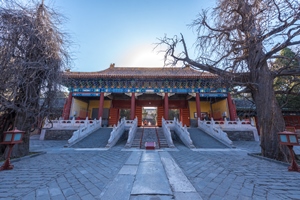
With the names, places of birth and ranking of 51,624 scholars of Ming and Qing Dynasties, the stone tablets are precious material for studying the Chinese Imperial Examination System. Outside Dacheng Gate is Qianlong Stone Drum, and there are two stone tablets of the Qing Dynasty. The main buildings in the middle courtyard are eastern and western counterpart houses and 13 imperial pavilions.
Ancient Chinese emperors paid high attention to the Beijing Confucian Temple which was founded in the Yuan Dynasty because of the importance of Confucianism in maintaining the feudal rule. Temples’ quantity, high specification, exquisite architectural technology and art are the most outstanding types of ancient Chinese architecture, and they are extremely important parts of Chinese ancient cultural heritage.
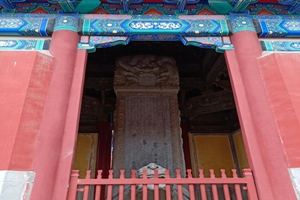
Beijing Confucian Temple was first built in the 14th century, the Yuan Dynasty. After Kublai Khan, the first emperor of the Yuan Dynasty took Beijing as the capital, he made friends with the feudal nobles and scholar-officials of the Han nationality to strengthen his ideological rule. And he ordered to inherit the traditions of the previous dynasties and ordered Golden Privy Council to build Xuansheng Temple to worship Confucius.
In 1307, Confucius was awarded the posthumous title of "The Most Holy Sage of Dacheng WenXuan King". This stone tablet with Imperial Edict still stands in front of the Dacheng Gate.
In 1331, the emperor decreed that The Confucian Temple should be built following the palace and turrets could be constructed in its four corners.
At the end of the Yuan Dynasty, The Confucius Temple was abandoned.
In 1411, Dacheng Hall was renovated.
In 1530, The Shrine was built to worship Confucius as well as his five generations of ancestors.
In 1737, the emperor ordered to use the noblest yellow glazed tile roof to replace the original one of the Beijing Confucian Temple, while only The Shrine was still covered the green glazed tile roof. At that time, Beijing Confucian Temple was resplendent.
In 1906, the ritual of worshiping Confucius was elevated to a greater rite, and Confucian Temples were renovated on a larger scale. But the work was not completed. After the Qing Dynasty being overthrown, the repair continued, and it was finally completed in 1916. Since then, Confucian Temple has formed its present scale and layout and became the second largest Confucian Temple in China, rank only second to Qufu Confucian Temple in Shandong Province.
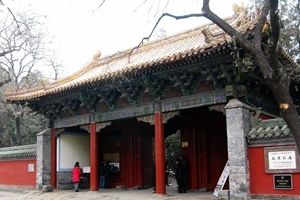
It is the front door of the Beijing Confucian Temple. There are glaze archways and a stone tablet in front of the gate. On the east side of inside the gate, there is The God Kitchen, The Well Pavilion, and The Slaughtering Pavilion. On the west side, there are Repository of God and The Zhizhai Room. The layout here is mysterious and elegant. The architectural style of the Yuan Dynasty has been preserved. The outer walls of the temple are connected with The Forerunner's Gate, which is like a city gate.
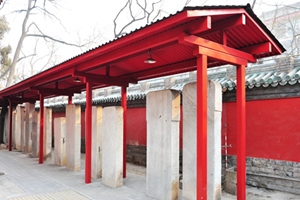
Scholars’ Stele Forest is displayed on both sides of The Dacheng Gate. There are 198 pieces of steles in total and each one is unique. Among them, there are 3 for the Yuan Dynasty, 77 for the Ming Dynasty and 118 for the Qing Dynasty. The steles are inscribed with the names, places of origin and ranking of these scholars. In the Imperial examinations of the Ming and Qing dynasties, 51,624 people were selected. The steles of some well-known figures of the Ming Dynasty, such as Yu Qian (a famous minister), Yuan Chonghuan (a general), and Lin Zexu (a minister who started the ban on opium-smoking and the opium trade) of the Qing Dynasty can all be found here.
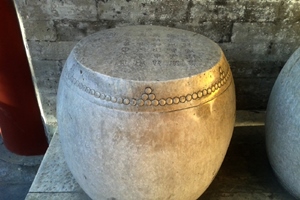
There are 10 stone drums in total, and they were originally exhibited inside the Dacheng Gate. They are the relics that belong to the 8th century BC (the period of King Xuan, of the Zhou Dynasty). Each drum is engraved with a four-character poem describing the story of King Xuan's safari. There are the world-famous inscriptions on drum-shaped stone blocks, which are rare cultural relics in China. But they have been moved to the Imperial Palace for collection and exhibition. The existing stone drums here are copies of the reign of Emperor Qianlong of the Qing Dynasty.
There are 14 imperial tablets in total and 11 ones of them which are inside the Dacheng Gate. Erected in the pavilion, the imperial tablets are on the east and west sides of the courtyard. They were built to record the historical events and the achievements of emperors.
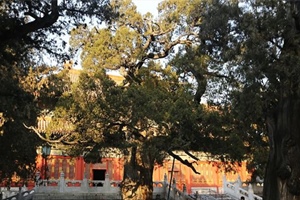
This cypress is the largest one in Beijing Confucian Temple. It is said that this cypress was planted by Xu Heng, the executive staff of The Imperial College in the Yuan Dynasty. It is about 700 years old. By now, it still has luxuriant foliage and extended branches. It is said that Yan Song, a traitor minister of the Ming Dynasty, when he attended the sacrificial activity on behalf of the Emperor Jiajing, went under the tree and the branch took off his black gauze hat. People thought that the cypress could identify who is the traitor.
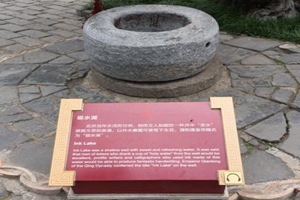
Ink Lake is an ancient well in Beijing Confucian Temple, which is located on the waterline between The Desheng Gate and The Anding Gate. The water tastes sweet and often overflows out of the well. According to legend, the examinee who would attend The Imperial Examination in Beijing visited Beijing Confucian Temple, they would be able to compose their thoughts and write fluently by drinking "holy water" of the well. The ink grounded with the water was also fragrant, examinee who used this ink could write a very good essay. Then the Emperor Qianlong named the well Ink Lake.
It is the main hall of the Beijing Confucian Temple. A portrait of Confucius and his memorial tablet are set in the main seat of the temple. On both sides of the main seat, there are tablets of Yan Hui, Kong Ji, Zeng Shen and Meng Ke(Confucius’ disciples). Also, there are twelve memorial tablets of philosophers on the east and west sides, such as Zhongtian, Zhu Xi and others. In the Qing Dynasty, there were two times of sacrificial activities in the middle of spring and autumn every year, which were held in this hall. To promote the traditional culture of the nation, there are still recreational "sacrifice to Confucius" ritual performances for visitors.
Take bus 116, 684, 13, 117 and get off at Yonghegong Station (The Lama Temple).
Take bus 13 or 684 get off at Guozijian Station.
By Subway
Take line2 or 5 and get off at Yonghegong Station (The Lama Temple), then walk south for about 2 minutes.
Chinese: 请带我去孔子庙。English: Please take me to Beijing Confucian Temple.
If you go to Beijing Confucian Temple from the center of Beijing(Tiananmen Square), it takes about 21 minutes (25 yuan).
If you go to Beijing Confucian Temple from the Beijing International Airport, it takes about 40 minutes (75 yuan).
If you go to Beijing Confucian Temple from the Beijing Daxing International Airport, it takes about 100 minutes (180 yuan).
If you go to Beijing Confucian Temple from the Beijing West Train Station, it takes about 20 minutes (40 yuan).
